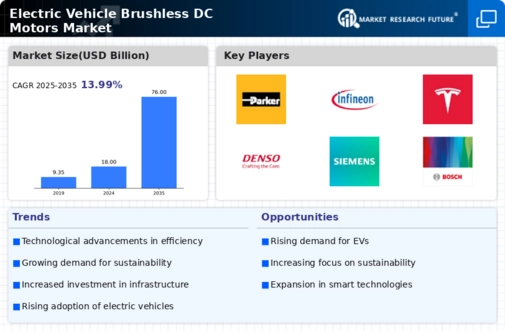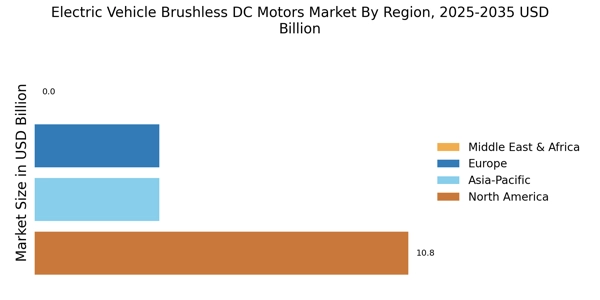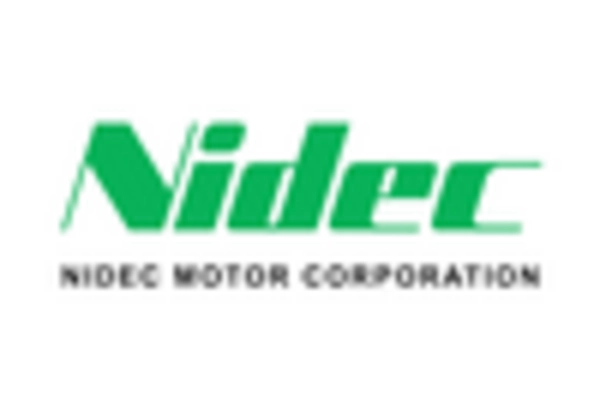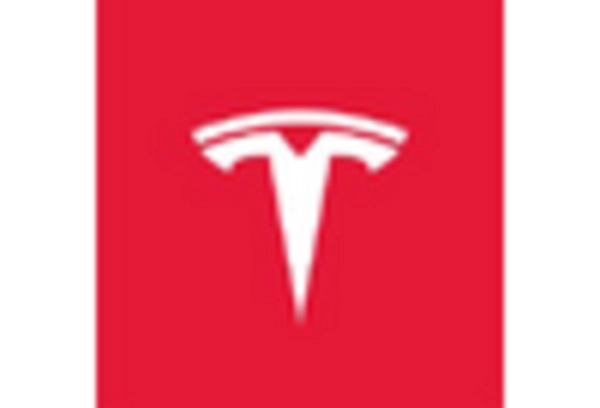Expansion of Charging Infrastructure
The Electric Vehicle Brushless DC Motors Market is poised for growth due to the ongoing expansion of charging infrastructure. As more charging stations become available, the practicality of owning electric vehicles increases, thereby driving demand for electric motors. Recent statistics reveal that the number of public charging stations has doubled in the last three years, facilitating easier access for electric vehicle owners. This expansion not only alleviates range anxiety among consumers but also encourages manufacturers to invest in electric vehicle technologies, including brushless DC motors. The availability of robust charging networks is likely to enhance the overall appeal of electric vehicles, further propelling the market for brushless DC motors as manufacturers respond to the increasing consumer demand for reliable and efficient electric mobility solutions.
Regulatory Support for Electric Vehicles
The Electric Vehicle Brushless DC Motors Market is significantly influenced by regulatory frameworks that promote the adoption of electric vehicles. Governments worldwide are implementing stringent emissions regulations and offering incentives for electric vehicle purchases, which in turn drives demand for efficient motor technologies. For instance, various countries have set ambitious targets for reducing greenhouse gas emissions, leading to an increased focus on electric mobility solutions. As a result, the market for brushless DC motors is projected to grow, with estimates indicating a compound annual growth rate of around 15% over the next five years. This regulatory support not only encourages manufacturers to invest in electric vehicle technologies but also fosters a competitive landscape that benefits consumers through improved product offerings.
Technological Innovations in Electric Motors
The Electric Vehicle Brushless DC Motors Market is experiencing a surge in technological innovations that enhance motor efficiency and performance. Advances in materials science, such as the development of high-energy magnets and lightweight composites, contribute to improved power-to-weight ratios. Furthermore, the integration of smart technologies, including sensors and control systems, allows for real-time monitoring and optimization of motor performance. According to recent data, the efficiency of brushless DC motors has increased by approximately 20% over the past few years, making them more appealing for electric vehicle manufacturers. This trend suggests that ongoing research and development efforts will continue to drive the market forward, as manufacturers seek to leverage these innovations to meet consumer demands for higher performance and lower energy consumption.
Rising Consumer Awareness of Environmental Issues
Consumer awareness regarding environmental sustainability is a pivotal driver for the Electric Vehicle Brushless DC Motors Market. As individuals become more conscious of their carbon footprints, there is a growing preference for electric vehicles that utilize brushless DC motors due to their efficiency and lower emissions. Market Research Future indicates that approximately 70% of consumers are willing to pay a premium for environmentally friendly vehicles, which directly impacts the demand for electric motors. This shift in consumer behavior is likely to encourage manufacturers to prioritize the development of electric vehicles equipped with advanced motor technologies. Consequently, the market for brushless DC motors is expected to expand as manufacturers align their product offerings with the evolving preferences of environmentally conscious consumers.
Collaborative Partnerships in the Automotive Sector
Collaborative partnerships within the automotive sector are emerging as a crucial driver for the Electric Vehicle Brushless DC Motors Market. Automakers are increasingly forming alliances with technology companies to enhance motor design and performance. These collaborations often focus on integrating advanced technologies such as artificial intelligence and machine learning into motor control systems, which can optimize efficiency and responsiveness. Recent data suggests that partnerships between automotive manufacturers and tech firms have led to a 30% reduction in development time for new electric vehicle models. Such synergies not only accelerate innovation but also enable manufacturers to bring more competitive products to market. As these partnerships continue to evolve, they are likely to play a significant role in shaping the future landscape of the electric vehicle brushless DC motors market.

















